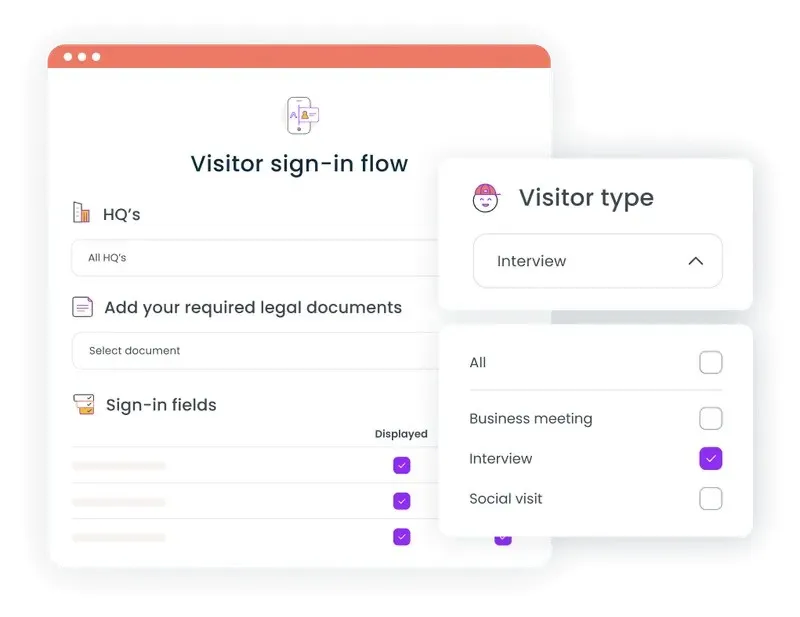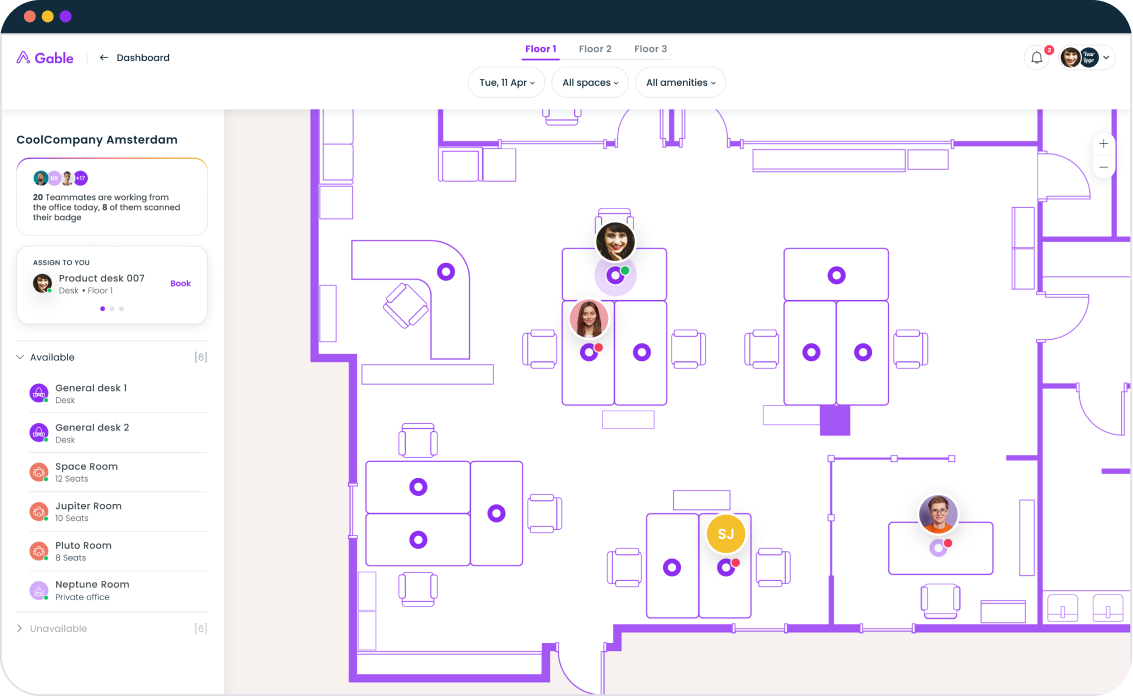Workplace compliance protects your employees, saves money, and creates the foundation for a productive, safe workplace. Companies with strong compliance programs avoid costly violations and create environments where teams can focus on what matters most.
Workplace compliance is about creating structured systems that protect your people, optimize your spaces, and keep your business running smoothly. With 2.6 million workplace injuries and illnesses reported in 2023 alone and the average cost of non-compliance hitting $15 million, getting workplace compliance right has never been more critical.
What is compliance in the workplace?
Workplace compliance means following all applicable laws, regulations, and internal compliance policies that govern how your business operates. This includes everything from occupational safety and workplace safety standards to data protection, labor law compliance, and visitor management protocols.
Modern workplace compliance covers three main areas:
Regulatory compliance involves adhering to external laws and compliance regulations specific to your industry. This includes OSHA standards, relevant laws, environmental regulations, and industry-specific workplace compliance requirements that vary by sector.
Corporate compliance focuses on the internal compliance policies and procedures that your organization creates to ensure ethical conduct and appropriate behavior. These company policies often exceed legal minimums and reflect your organizational values.
Operational compliance ensures day-to-day activities meet both regulatory and corporate standards. This includes everything from access management and visitor protocols to safe working environment maintenance and employee health requirements.
The challenge isn't understanding what compliance means—it's implementing systems that work for modern, often distributed workplaces while maintaining the flexibility teams need to be productive.
Why workplace compliance matters more than ever
87% of organizations report negative outcomes from low compliance, but the stakes go far beyond avoiding legal penalties. Here's why compliance deserves your attention:
Financial protection
Non-compliance costs are staggering. The average cost of regulatory non-compliance reaches $14.8 million per incident, while maintaining strong compliance programs typically costs around $5.47 million annually. That's a net benefit of almost $10 million for companies that get compliance efforts right.
McKinsey research shows that financial institutions alone have faced over $300 billion in compliance-related fines since 2008. The pattern is clear: proactive compliance investment pays for itself many times over.
Employee health and operational efficiency gains
Strong compliance programs create safer working environments that boost productivity. OSHA data shows workplace fatalities have dropped from 38 deaths per day in 1970 to 15 per day in 2023, mainly due to improved compliance with workplace safety standards and training programs.
When employees feel safe and know their workplace follows clear procedures, they can focus on their work instead of worrying about potential hazards or unclear company policies. This translates directly to better performance and higher retention rates.
Risk management for the modern workplace
Companies with continuous compliance approaches report 74% better business outcomes compared to organizations using reactive, point-in-time compliance methods. The difference lies in building systems that prevent problems rather than responding to them after they occur.
Essential compliance requirements every workplace needs
Occupational safety and health administration compliance
OSHA compliance forms the foundation of workplace safety. Fall protection, hazard communication, and lockout/tagout procedures rank as the top three most cited standards, indicating where many organizations struggle with non-compliance.
Key OSHA requirements include:
- Maintaining injury and illness records (Form 300, 300A, and 301)
- Providing required compliance training for all employees
- Implementing hazard communication programs
- Ensuring proper personal protective equipment usage
- Conducting regular safety inspections and internal compliance audits
The goal isn't just avoiding citations—it's creating work environments where people can perform their best work safely while maintaining compliance with relevant regulations.
Labor law compliance essentials
Labor laws protect employee rights and establish fair working conditions. Labor law compliance encompasses wage and hour requirements, equal employment opportunity, family and medical leave, and workers' compensation, as outlined in relevant federal and state laws.
Core areas include:
- Fair Labor Standards Act (FLSA) compliance for wages and overtime
- Equal Employment Opportunity Commission (EEOC) guidelines
- Family and Medical Leave Act (FMLA) administration
- State-specific labor regulations and local laws
- Immigration law compliance (I-9 verification)
Data protection officer responsibilities
With 88% of companies spending over $1 million annually on GDPR compliance alone, data protection has become a primary compliance focus. This includes protecting personal information, securing sensitive data, and ensuring appropriate access controls.
Data protection compliance involves:
- GDPR compliance for organizations handling EU citizen data
- CCPA compliance for businesses serving California residents
- Industry standards for data protection requirements
- Secure data storage and transmission procedures
- Employee training on data handling responsibilities
Access control and visitor management compliance
Modern workplaces require robust systems to manage facility access and entry times. This is about compliance with various regulations that require organizations to track and control access to sensitive areas and maintain compliance with separate standards.

Discover how Gable's visitor management solution helps organizations maintain secure, compliant access control while creating a welcoming experience for guests and employees.
Learn More About Visitor Management
Building an effective compliance program
Start with a comprehensive compliance assessment
Before building new systems, understand your current state. 74% of organizations report they cannot adequately address vulnerabilities due to limited budgets and resources, often because they haven't accurately mapped their compliance landscape.
Conduct a thorough assessment covering all applicable federal contractors' requirements, state laws, industry-specific compliance requirements, current policies and procedures, existing compliance tools, and risk areas needing immediate attention.
Create a dedicated compliance management team
Successful compliance requires dedicated leadership. Companies with continuous compliance programs are 67% more likely to have larger, more capable teams compared to organizations using reactive approaches.
Your compliance team should include:
- Compliance manager who stays current on relevant laws and regulations
- Data protection officer responsible for privacy and data security
- Risk management officer who identifies and addresses organizational vulnerabilities
- Compliance officer who ensures day-to-day adherence to corporate policies
Implement compliance technology and tools
The right technology doesn't just help you maintain compliance—it makes compliance processes more efficient and less burdensome for employees. Essential compliance technology includes document management systems, training platforms, incident reporting tools, audit management systems, and visitor management platforms.
Develop comprehensive training programs
80-90% of serious workplace injuries are caused by human error, making compliance training one of your most essential compliance investments. Effective training goes beyond one-time sessions to create ongoing education that keeps compliance top-of-mind.
Successful training programs include role-specific compliance training, regular refresher sessions, interactive elements that engage employees, clear documentation of completion, and assessment to verify understanding of company values and procedures.
Workplace compliance in the hybrid era
New challenges for distributed teams
The shift to hybrid and remote work has created compliance challenges that didn't exist in traditional office environments. Organizations must now ensure compliance across multiple locations, including home offices, coworking spaces, and traditional headquarters.
Creating a comprehensive hybrid work policy becomes essential for maintaining compliance across distributed teams. Key considerations include ensuring ergonomic and safety standards in remote locations, managing data security across multiple work environments, tracking employee whereabouts for emergency response, maintaining consistent policies, and managing visitor access at multiple facilities.
Space management and operational efficiency
Office space optimization has become crucial for hybrid organizations, but it must be balanced with compliance requirements. This includes ensuring adequate space for safety equipment, maintaining proper occupancy limits, and managing visitor access effectively.
Modern space management compliance involves dynamic space allocation based on usage patterns, visitor management integration with space booking systems, emergency evacuation planning for variable occupancy, and accessibility compliance across all work areas. Understanding how to create a future-proof workplace strategy helps organizations balance compliance requirements with operational efficiency. Companies using data-driven space management report significant cost savings while maintaining full compliance with safety requirements.
Learn how Gable's office management tools help organizations balance space efficiency with safety requirements, ensuring compliance while maximizing real estate investments.
Explore Office Management
Common compliance challenges and solutions
Documentation and record-keeping struggles
Many organizations struggle with maintaining the comprehensive documentation required for compliance. Streamline documentation by implementing cloud-based management systems, creating standardized templates, automating data collection, establishing clear retention policies, and training employees on proper procedures.
Keeping up with changing regulations
Regulatory change happens constantly, and keeping current requires dedicated effort. Stay current by subscribing to regulatory update services, joining professional associations, attending compliance training programs, working with legal counsel for complex interpretation, and implementing change management processes.
Employee engagement and training fatigue
Compliance training often feels burdensome to employees, leading to poor engagement. Improve engagement through role-specific training, interactive methods including simulations, clear explanations of why compliance matters, recognition programs for strong performance, and regular feedback opportunities.
Technology integration and data management
Modern workplaces use multiple systems that must work together for effective compliance management. Solve integration challenges by selecting technology with strong integration capabilities, implementing single sign-on access, creating data sharing protocols, training employees on platforms, and conducting regular system audits.
Advanced compliance strategies
Risk-based compliance approaches
Smart organizations implement risk-based approaches that focus resources on areas with the highest potential impact. This involves identifying high-risk areas, allocating resources based on potential impact, implementing frequent monitoring for high-risk areas, creating escalation procedures, and regular reassessment as conditions change.
Continuous monitoring and improvement
Organizations with continuous compliance approaches report significantly better outcomes than those using point-in-time methods. Implement continuous monitoring through automated reporting systems, regular internal audits, real-time data collection, employee feedback mechanisms, and integration of compliance metrics into performance management.
Cultural integration and leadership commitment
Sustainable compliance requires embedding compliance thinking into organizational culture. This approach extends beyond training to integrate compliance into the daily workflow, particularly as organizations adapt to the hybrid office model.
Build a compliance culture through leadership modeling, recognition programs, clear communication about expectations, employee involvement in policy development, and regular communication about successes and challenges.
Measuring compliance success
Key performance indicators for compliance
Effective measurement goes beyond counting violations to assess overall program health. Essential compliance KPIs include incident rate trends, training completion rates, time to resolve issues, employee satisfaction with processes, and cost avoidance through proactive measures.
Return on investment calculation
Companies with strong compliance programs typically save 2.71 times more than they spend through avoided penalties and incidents. Track ROI through direct cost savings, reduced insurance costs, productivity gains, employee retention improvements, and brand reputation protection value.
Technology solutions for modern compliance
Modern compliance management requires platforms that bring together multiple functions in one place. Key capabilities include visitor management with compliance tracking, space management with safety monitoring, document management with audit trails, training management with progress tracking, and incident management with investigation workflows.
Organizations implementing hybrid work software find that integrated platforms significantly reduce compliance complexity while improving employee experience across distributed teams.
Gable's integrated platform combines visitor management, space booking, and workplace analytics to help you maintain compliance while optimizing workplace operations.
Get a demo





.svg)





.svg)
























